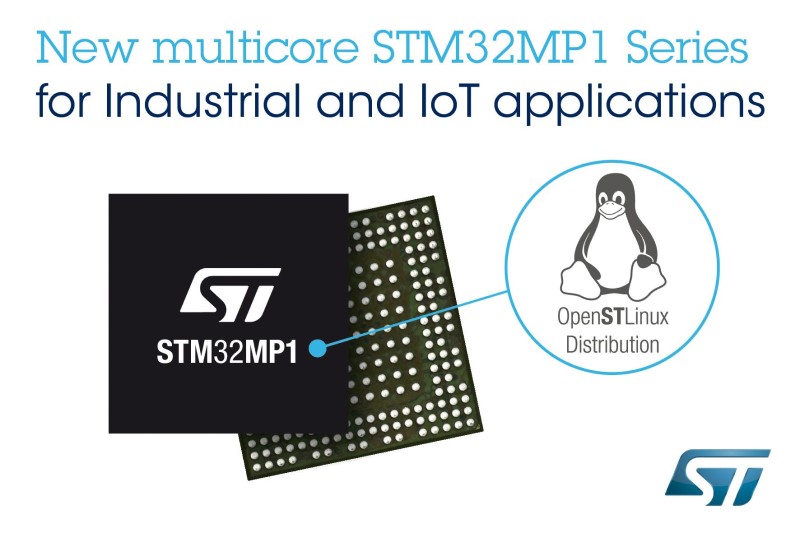New STM32MP1 Dual Arm Core Microprocessor Series with Speeds to 800MHz
STMicroelectronics Dual Core Microprocessors combine a Arm® Cortex®-A7 application processor core with a Cortex-M4 core
STMicroelectronics is expanding its STM32MP1 microprocessor (MPU) offering with the addition of new authorized partners, new software functionalities, and a significant performance bump by increasing the clock speed to 800MHz, maintaining software and pin-to-pin compatibility with the 650MHz devices.

The new STM32MP1 MPUs, now running dual Arm® Cortex®-A7 application processor cores at 800MHz and the Cortex-M4 core at 209MHz, deliver more performance in Voice and Audio Processing, up to HD Video Decoding quality, more powerful AI (Artificial Intelligence) capabilities in Neural-Network and Machine-Learning applications, and better user experience in Android systems. The devices feature compute and 3D graphics accelerators combined with power-efficient real-time control and high feature integration.
“The popular HMI toolkit Qt and its QML-based GUI applications can be deployed on STM32 MCUs as well as on the STM32MP1 platform, thereby drastically reducing development costs while accelerating customer product delivery,” said Petteri Holländer, SVP, The Qt Company. “The scalability provided by both ST & Qt tools suite can easily leverage the resources of the STM32MP1, especially the 3D HW GPU accelerator to optimize a smooth rendering for HMI Industrial / IoT applications.”
Capitalizing on the flexible STM32MP1 architecture, the security has been enhanced to protect the customer’s code through features like secure boot by authentication, available One-Time Programmable fuses for customers, and a secure operating system (OP-TEE: Trusted Execution Environment). A complete security toolset including Keys Generator, Signing Tools, STM32CubeProgrammer, and Hardware Security Module (STM32HSM) allows secure provisioning of the customers’ secrets into the device.
The OpenSTLinux Distribution as a mainlined open-source Linux with all the essential building blocks for running software on the application-processor cores is now supplemented with Android developer packages and Cloud support to accelerate customer development. ST continues to actively participate in the Linux community with its strong mainlining strategy.
“ST’s active participation to the Linux kernel community always impressed us. The simultaneous Linux & STM32MP1 availability made this launch attractive,” said Michael Opdenacker, CEO of Bootlin. “In our opinion, ST understood what the customer’s interests are: mainline versions support of open-source projects, freedom to upgrade to newer versions, zero-cost availability of security updates, community support and security of their long-term investments. By sharing the same open-source DNA, Bootlin is proud to be an ST Authorized Partner and to offer to worldwide customers its engineering and training services on this platform.”
On top of the strong software tool offer including STM32CubeMX and STM32CubeProgrammer, the STM32CubeIDE debugger is now available on Cortex M-4 core.
Features of the top of the line STM32MP157C dual Arm® Cortex®-A7 Microcontroller include
- Cores
- 32-bit dual-core Arm® Cortex®-A7
- L1 32-Kbyte I / 32-Kbyte D for each core
- 256-Kbyte unified level 2 cache
- Arm® NEON™ and Arm® TrustZone®
- 32-bit Arm® Cortex®-M4 with FPU/MPU
- 32-bit dual-core Arm® Cortex®-A7
- Memories
- External DDR memory up to 1 Gbyte
- 708 Kbytes of internal SRAM
- Dual mode Quad-SPI memory interface
- Flexible external memory controller with up to 16-bit data bus
- Security/safety
- Secure boot, TrustZone® peripherals, active tamper
- Cortex®-M4 resources isolation
- Reset and power management
- 1.71 V to 3.6 V I/Os supply (5 V-tolerant I/Os)
- POR, PDR, PVD and BOR
- Internal temperature sensors
- Low-power modes: Sleep, Stop and Standby
- DDR memory retention in Standby mode
- Low-power consumption
- Total current consumption down to 2 µA
- Clock management
- Internal oscillators: 64 MHz HSI oscillator, 4 MHz CSI oscillator, 32 kHz LSI oscillator
- External oscillators: 8-48 MHz HSE oscillator, 32.768 kHz LSE oscillator
- 6 × PLLs with fractional mode
- General-purpose input/outputs
- Up to 176 I/O ports with interrupt capability
- Up to 37 communication peripherals
- 6 × I²C FM+ (1 Mbit/s, SMBus/PMBus)
- 4 × UART + 4 × USART
- 6 × SPI
- 4 × SAI (stereo audio: I2S, PDM, SPDIF Tx)
- SPDIF Rx with 4 inputs
- HDMI-CEC interface
- MDIO Slave interface
- 3 × SDMMC up to 8-bit
- 2 × CAN controllers supporting CAN FD protocol
- 2 × USB 2.0 high-speed Host + 1 × USB 2.0 full-speed OTG simultaneously
- 10/100M or Gigabit Ethernet GMAC
- 8- to 14-bit camera interface up to 140 Mbyte/s
- 6 analog peripherals
- 2 × ADCs with 16-bit max. resolution
- 1 × temperature sensor
- 2 × 12-bit D/A converters
- 1 × digital filters for sigma delta modulator with 8 channels/6 filters
- Internal or external ADC/DAC reference VREF+
- Graphics
- 3D GPU: Vivante® - OpenGL® ES 2.0, Up to 26 Mtriangle/s, 133 Mpixel/s
- LCD-TFT controller, up to 24-bit // RGB888
- MIPI® DSI 2 data lanes up to 1 GHz each
- Up to 29 timers and 3 watchdogs
- 2 × 32-bit timers with up to 4 IC/OC/PWM
- 2 × 16-bit advanced motor control timers
- 10 × 16-bit general-purpose timers
- 5 × 16-bit low-power timers
- RTC with sub-second accuracy and hardware calendar
- 2 × 4 Cortex®-A7 system timers
- 1 × SysTick M4 timer
- 3 × watchdogs
- Hardware acceleration
- AES 128, 192, 256, TDES
- HASH (MD5, SHA-1, SHA224, SHA256), HMAC
- 2 × true random number generator
- 2 × CRC calculation unit
- Debug mode
- Arm® CoreSight™ trace and debug: SWD and JTAG interfaces
- 8-Kbyte embedded trace buffer
- 3072-bit fuses including 96-bit unique ID, up to 1184-bit available for user
More information on the STM32MP1 MCUs is available on the ST website at STM32 Arm Cortex MPUs main page.
The STMicroelectronics website address is www.st.com
[Reprinted with kind permission from STMicroelectronics - Release Date, 25th February, 2020]


 About Us
About Us